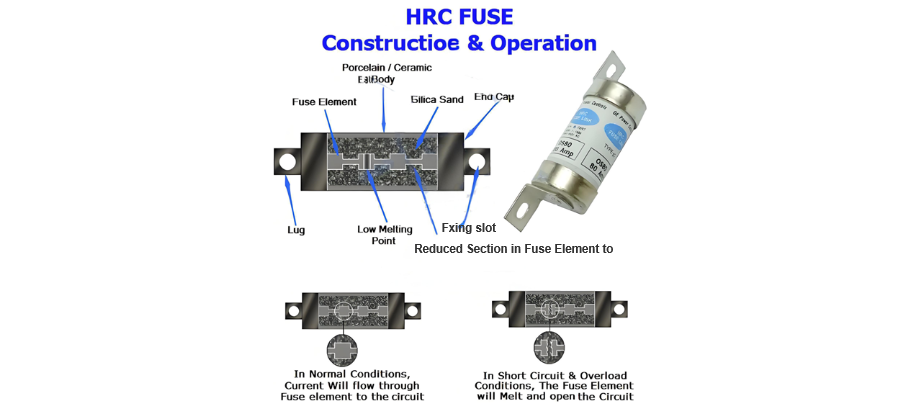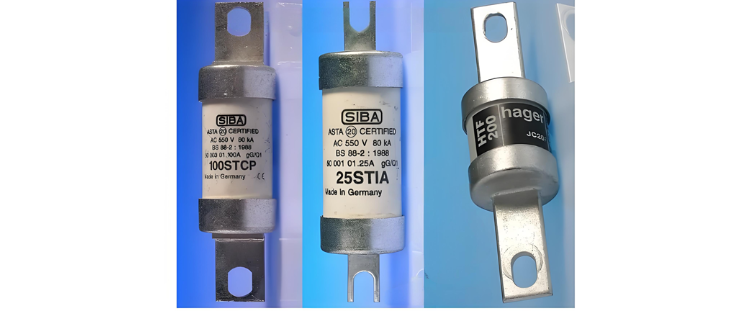HRC Fuse (High Rupturing Capacity Fuse) and its Types
Edwiin
05/19/2025


When a fault occurs, the silver fuse element blows first, and the current is transferred to the tungsten wire. The plunger's stroke is designed such that it does not eject from the fuse body during fault conditions.
Advantages of HRC Fuse with Tripping Device
- Single-Phase Fault Protection in Three-Phase Systems:When a single-phase fault occurs in a three-phase system, the plunger trips the circuit breaker, opening all three phases simultaneously to prevent unbalanced single-phase power supply.
- Cost Reduction for Circuit Breakers:By allowing the fuse to handle the primary interruption of fault currents, the circuit breaker only needs to account for the effects of short circuits, enabling the use of less expensive breaker models.
- Reduced Fuse Replacement Frequency:The tripped circuit breaker can handle small currents, eliminating the need to replace the fuse frequently (except in cases of high-current faults).
- High Breaking Capacity Range:Low-voltage HRC fuses are available with breaking capacities ranging from 16,000A to 30,000A at 400V (some models extend to 80kA to 120kA), widely used for overload and short-circuit protection in low-voltage distribution systems.
Types of HRC Fuse
- NH Fuse
- Din Type
- Blade Contact

Disadvantages
Applications
Topics

What is Automatic Voltage Regulator?
An automatic voltage regulator is employed to regulate voltage, converting fluctuating voltages into a constant one. Voltage fluctuations mainly stem from variations in the load on the supply system. Such voltage variations can damage the equipment within the power system. These fluctuations can be mitigated by installing voltage - control equipment at various locations, such as near transformers, generators, and feeders. Multiple voltage regulators are often placed throughout the power system t
Edwiin
05/22/2025

What is Static Voltage Regulator?
Types of Static Voltage RegulatorThe static voltage regulator is superior to electromechanical regulators in respect of the accuracy of control, response, reliability and maintenance. The static voltage regulator is mainly classified into two types. They are;Servo Type Voltage RegulatorMagnetic Amplifier RegulatorThe types of static voltage regulator are described below in details;Servo Type Voltage RegulatorThe main feature of the servo type voltage regulator is the use of the amplidyne. The am
Edwiin
05/21/2025

What is Arc Extinction Circuit Breaker?
When the current-carrying contacts of a circuit breaker separate, an arc forms and persists briefly after contact separation. This arc is hazardous due to the heat energy it generates, which can produce explosive forces.A circuit breaker must extinguish the arc without damaging equipment or endangering personnel. The arc significantly influences the breaker’s performance. Interrupting aDC arcis inherently more challenging than anAC arc. In an AC arc, the current naturally reaches zero duri
Edwiin
05/20/2025

Air Break Circuit Breaker
In an air break circuit breaker, the arc is initiated and extinguished in substantially static air as the arc moves. These breakers are used for low voltages, generally up to 15 kV, with rupturing capacities of 500 MVA. As an arc-quenching medium, air circuit breakers offer several advantages over oil, including:Elimination of risks and maintenance associated with oil use.Absence of mechanical stress caused by gas pressure and oil movement.Elimination of costs from regular oil replacement due to
Edwiin
05/20/2025









